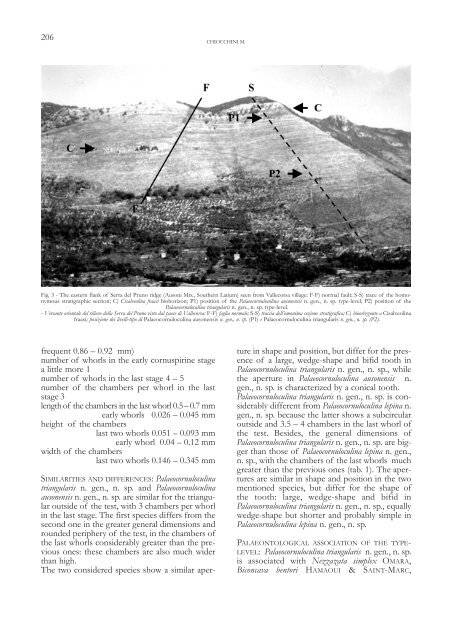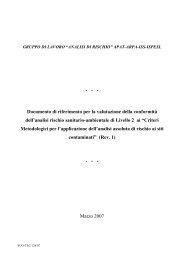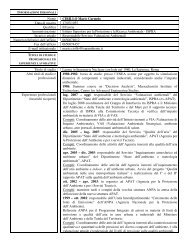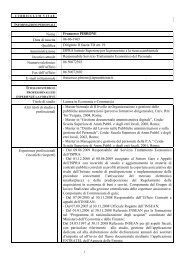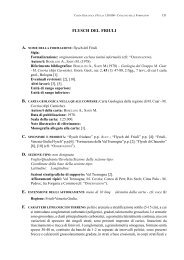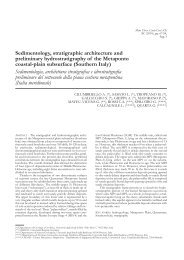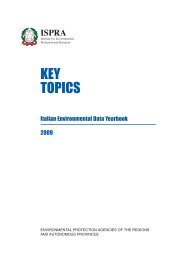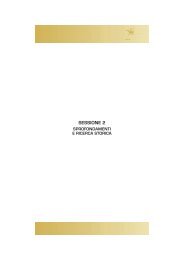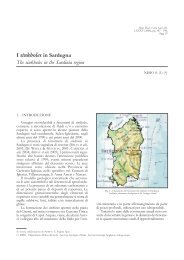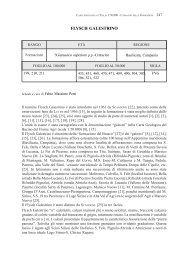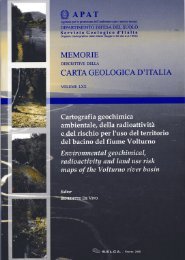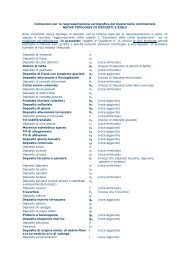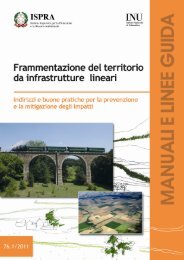Chiocchini M. - Ispra
Chiocchini M. - Ispra
Chiocchini M. - Ispra
You also want an ePaper? Increase the reach of your titles
YUMPU automatically turns print PDFs into web optimized ePapers that Google loves.
206 CHIOCCHINI M.<br />
Fig. 3 - The eastern flank of Serra del Pruno ridge (Ausoni Mts., Southern Latium) seen from Vallecorsa village: F-F) normal fault; S-S) trace of the homonymous<br />
stratigraphic section; C) Cisalveolina fraasi biohorizon; P1) position of the Palaeocornuloculina ausonensis n. gen., n. sp. type-level; P2) position of the<br />
Palaeocornuloculina triangularis n. gen., n. sp. type-level.<br />
- Versante orientale del rilievo della Serra del Pruno visto dal paese di Vallecorsa: F-F) faglia normale; S-S) traccia dell’omonima sezione stratigrafica; C) bioorizzonte a Cisalveolina<br />
fraasi; posizione dei livelli-tipo di Palaeocornuloculina ausonensis n. gen., n. sp. (P1) e Palaeocornuloculina triangularis n. gen., n. sp. (P2).<br />
frequent 0.86 – 0.92 mm)<br />
number of whorls in the early cornuspirine stage<br />
a little more 1<br />
number of whorls in the last stage 4 – 5<br />
number of the chambers per whorl in the last<br />
stage 3<br />
length of the chambers in the last whorl 0.5 – 0.7 mm<br />
early whorls 0.026 – 0.045 mm<br />
height of the chambers<br />
last two whorls 0.051 – 0.093 mm<br />
early whorl 0.04 – 0.12 mm<br />
width of the chambers<br />
last two whorls 0.146 – 0.345 mm<br />
SIMILARITIES AND DIFFERENCES: Palaeocornuloculina<br />
triangularis n. gen., n. sp. and Palaeocornuloculina<br />
ausonensis n. gen., n. sp. are similar for the triangular<br />
outside of the test, with 3 chambers per whorl<br />
in the last stage. The first species differs from the<br />
second one in the greater general dimensions and<br />
rounded periphery of the test, in the chambers of<br />
the last whorls considerably greater than the previous<br />
ones: these chambers are also much wider<br />
than high.<br />
The two considered species show a similar aper-<br />
ture in shape and position, but differ for the presence<br />
of a large, wedge-shape and bifid tooth in<br />
Palaeocornuloculina triangularis n. gen., n. sp., while<br />
the aperture in Palaeocornuloculina ausonensis n.<br />
gen., n. sp. is characterized by a conical tooth.<br />
Palaeocornuloculina triangularis n. gen., n. sp. is considerably<br />
different from Palaeocornuloculina lepina n.<br />
gen., n. sp. because the latter shows a subcircular<br />
outside and 3.5 – 4 chambers in the last whorl of<br />
the test. Besides, the general dimensions of<br />
Palaeocornuloculina triangularis n. gen., n. sp. are bigger<br />
than those of Palaeocornuloculina lepina n. gen.,<br />
n. sp., with the chambers of the last whorls much<br />
greater than the previous ones (tab. 1). The apertures<br />
are similar in shape and position in the two<br />
mentioned species, but differ for the shape of<br />
the tooth: large, wedge-shape and bifid in<br />
Palaeocornuloculina triangularis n. gen., n. sp., equally<br />
wedge-shape but shorter and probably simple in<br />
Palaeocornuloculina lepina n. gen., n. sp.<br />
PALAEONTOLOGICAL ASSOCIATION OF THE TYPE-<br />
LEVEL: Palaeocornuloculina triangularis n. gen., n. sp.<br />
is associated with Nezzazata simplex OMARA,<br />
Biconcava bentori HAMAOUI & SAINT-MARC,


